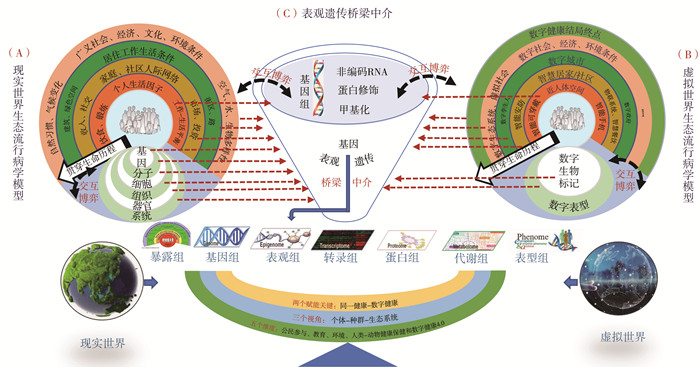| [1] |
Susser M, Susser E. Choosing a future for epidemiology: Ⅱ. From black box to Chinese boxes and eco-epidemiology[J]. Am J Public Health, 1996, 86(5): 674-677. DOI: 10.2105/ajph.86.5.674.
|
| [2] |
Bain LE, Awah PK. Eco-epidemiology: challenges and opportunities for tomorrow's epidemiologists[J]. Pan Afr Med J, 2014, 17: 317. DOI: 10.11604/pamj.2014.17.317.4080.
|
| [3] |
Eremeeva ME, Dasch GA. Challenges posed by tick-borne rickettsiae: eco-epidemiology and public health implications[J]. Front Public Health, 2015, 3: 55. DOI: 10.3389/fpubh.2015.00055.
|
| [4] |
Moinet M, Wilkinson DA, Aberdein D, et al. Of mice, cattle, and men: a review of the eco-epidemiology of leptospira borgpetersenii serovar ballum[J]. Trop Med Infect Dis, 2021, 6(4): 189. DOI: 10.3390/tropicalmed6040189.
|
| [5] |
Matei IA, Estrada-Peña A, Cutler SJ, et al. A review on the eco-epidemiology and clinical management of human granulocytic anaplasmosis and its agent in Europe[J]. Parasit Vectors, 2019, 12(1): 1-19. DOI: 10.1186/s13071-019-3852-6.
|
| [6] |
Sato Y, Hermawan I, Kakita T, et al. Analysis of human clinical and environmental Leptospira to elucidate the eco-epidemiology of leptospirosis in Yaeyama, subtropical Japan[J]. PLos Negl Trop Dis, 2022, 16(3): e0010234. DOI: 10.1371/journal.pntd.0010234.
|
| [7] |
Nadal C, Bonnet SI, Marsot M. Eco-epidemiology of equine piroplasmosis and its associated tick vectors in Europe: A systematic literature review and a meta-analysis of prevalence[J]. Transbound Emerg Dis, 2022, 169(5): 2474-2498. DOI: 10.1111/tbed.14261.
|
| [8] |
Diuk-Wasser MA, Vanacker MC, Fernandez MP. Impact of land use changes and habitat fragmentation on the eco-epidemiology of tick-borne diseases[J]. J Med Entomol, 2021, 58(4): 1546-1564. DOI: 10.1093/jme/tjaa209.
|
| [9] |
Kirkbride JB, Jones PB. The prevention of schizophrenia-what can we learn from eco-epidemiology?[J]. Schizophr Bull, 2011, 37(2): 262-271. DOI: 10.1093/schbul/sbq120.
|
| [10] |
Babor TF. Echological validity or ecological fallacy? Toward an eco-epidemiology for alcohol studies[J]. Addiction, 2000, 95(1): 53.
|
| [11] |
Susser E. Eco-epidemiology: thinking outside the black box[J]. Epidemiology, 2004, 15(5): 519-520. DOI: 10.1097/01.ede.0000135911.42282.b4.
|
| [12] |
Göran D, Whitehead M. Policies and strategies to promote social equity in health[J]. 1991.
|
| [13] |
Coutts C, Hahn M. Green infrastructure, ecosystem services, and human health[J]. Int J Env Res Pub He, 2015, 12(8): 9768-9798. DOI: 10.3390/ijerph120809768.
|
| [14] |
Centers for Disease Control and Prevention. Social ecological model (2015)[EB/OL]. (2022-01-18)[2022-07-18]. https://www.cdc.gov/riolenceprevention/about/social-ecologicalmodel.html.
|
| [15] |
Whitmee S, Haines A, Beyrer C, et al. Safeguarding human health in the Anthropocene epoch: report of The Rockefeller Foundation-Lancet Commission on planetary health[J]. The lancet, 2015, 386(10007): 1973-2028. DOI: 10.1016/s0140-6736(15)60901-1.
|
| [16] |
Wolfson MC. POHEM: a framework for understanding and modelling the health of human populations[J]. World Health Stat Q, 1994, 47(3-4): 157-176.
|
| [17] |
Schoner J, Chapman J, Brookes A, et al. Bringing health into transportation and land use scenario planning: creating a National Public Health Assessment Model (N-PHAM)[J]. J Transp Health, 2018, 10: 401-418. DOI: 10.1016/j.jth.2018.04.008.
|
| [18] |
Calistri P, Iannetti S, L. Danzetta M, et al. The components of 'one world-one health'approach[J]. Transbound Emerg Dis, 2013, 60: 4-13. DOI: 10.1111/tbed.12145.
|
| [19] |
Woldehanna S, Zimicki S. An expanded One Health model: integrating social science and One Health to inform study of the human-animal interface[J]. Soc Sci Med, 2015, 129: 87-95. DOI: 10.1016/j.socscimed.2014.10.059.
|
| [20] |
Destoumieux-Garzón D, Mavingui P, Boetsch G, et al. The one health concept: 10 years old and a long road ahead[J]. Front Vet Sci, 2018, 12: 14. DOI: 10.3389/fvets.2018.00014.
|
| [21] |
Van Bruggen AH, Goss EM, Havelaar A, et al. One Health-Cycling of diverse microbial communities as a connecting force for soil, plant, animal, human and ecosystem health[J]. Sci Total Environ, 2019, 664: 927-937. DOI: 10.1016/j.scitotenv.2019.02.091.
|
| [22] |
March D, Susser E. The eco-in eco-epidemiology[J]. Int J Epidemiol, 2006, 35(6): 1379-1383. DOI: 10.1093/ije/dyl249.
|
| [23] |
Guhl F, Auderheide A, Ramírez JD. From ancient to contemporary molecular eco-epidemiology of Chagas disease in the Americas[J]. Int J Parasitol, 2014, 44(9): 605-612. DOI: 10.1016/j.ijpara.2014.02.005.
|
| [24] |
Rice L, Sara R. Updating the determinants of health model in the Information Age[J]. Health Promot Int, 2019, 34(6): 1241-1249. DOI: 10.1093/heapro/day064.
|
| [25] |
Shields RK, Dudley-Javoroski S. Epigenetics and the International Classification of Functioning, Disability and Health model: bridging nature, nurture, and patient-centered population health[J]. Phys Ther, 2022, 102(1): pzab247. DOI: 10.1093/ptj/pzab247.
|
| [26] |
Benis A, Tamburis O, Chronaki C, et al. One digital health: a unified framework for future health ecosystems[J]. J Med Internet Res, 2021, 23(2): e22189. DOI: 10.2196/22189.
|
| [27] |
What is One Health? One health commission[EB/OL]. (2021-12-01)[2022-07-18]. https://www.onehealthcommission.org/en/why_one_health/what_is_one_health.
|
| [28] |
World Health Organization. Integrated control of neglected zoonotic diseases in Africa: applying the one health concept[EB/OL]. (2009-04-15)[2022-07-18]. https://www.oie.int/en/for-the-media/onehealth.
|
| [29] |
One Health. World health organization[EB/OL]. (2017-09-21)[2022-07-18]. https://www.who.int/news-room/q-a-detail/one-health.
|
| [30] |
Thuemmler C, Bai C. Health 4.0: how virtualization and big data are revolutionizing healthcare || security for cyber-physical systems in healthcare[J]. 2017, DOI: 10.1007/978-3-319-47617-9_12.
|





 下载:
下载:

